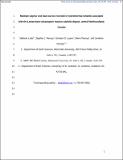Files in this item
Multiple sulphur and lead sources recorded in hydrothermal exhalites associated with the Lemarchant volcanogenic massive sulphide deposit, central Newfoundland, Canada
Item metadata
| dc.contributor.author | Lode, Stefanie | |
| dc.contributor.author | Piercey, Stephen J. | |
| dc.contributor.author | Layne, Graham D. | |
| dc.contributor.author | Piercey, Glenn | |
| dc.contributor.author | Cloutier, Jonathan | |
| dc.date.accessioned | 2017-04-12T23:34:10Z | |
| dc.date.available | 2017-04-12T23:34:10Z | |
| dc.date.issued | 2017-01 | |
| dc.identifier | 242241118 | |
| dc.identifier | 416a225a-b286-4355-8afc-8f1d6e5b5006 | |
| dc.identifier | 84963642309 | |
| dc.identifier | 000392126400006 | |
| dc.identifier.citation | Lode , S , Piercey , S J , Layne , G D , Piercey , G & Cloutier , J 2017 , ' Multiple sulphur and lead sources recorded in hydrothermal exhalites associated with the Lemarchant volcanogenic massive sulphide deposit, central Newfoundland, Canada ' , Mineralium Deposita , vol. 52 , no. 1 , pp. 105-128 . https://doi.org/10.1007/s00126-016-0652-1 | en |
| dc.identifier.issn | 0026-4598 | |
| dc.identifier.other | ORCID: /0000-0002-9432-9880/work/29685349 | |
| dc.identifier.uri | https://hdl.handle.net/10023/10616 | |
| dc.description | This research is funded by the Canadian Mining Research Organization (CAMIRO) and an NSERC CRD grant. Research is also funded by the NSERC-Altius Industrial Research Chair in Mineral Deposits, funded by NSERC, Altius Resources Inc. and the Development Corporation of Newfoundland and Labrador. | en |
| dc.description.abstract | Metalliferous sedimentary rocks (mudstones, exhalites) associated with the Cambrian precious metal-bearing Lemarchant Zn-Pb-Cu-Au-Ag-Ba volcanogenic massive sulphide (VMS) deposit, Tally Pond volcanic belt, precipitated both before and after VMS mineralization. Sulphur and Pb isotopic studies of sulphides within the Lemarchant exhalites provide insight into the sources of S and Pb in the exhalites as a function of paragenesis and evolution of the deposit and subsequent post-depositional modification. In situ S isotope microanalyses of polymetallic sulphides (euhedral and framboidal pyrite, anhedral chalcopyrite, pyrrhotite, galena and euhedral arsenopyrite) by secondary ion mass spectrometry (SIMS) yielded δ34S values ranging from −38.8 to +14.4 ‰, with an average of ∼ −12.8 ‰. The δ34S systematics indicate sulphur was predominantly biogenically derived via microbial/biogenic sulphate reduction of seawater sulphate, microbial sulphide oxidation and microbial disproportionation of intermediate S compounds. These biogenic processes are coupled and occur within layers of microbial mats consisting of different bacterial/archaeal species, i.e., sulphate reducers, sulphide oxidizers and those that disproportionate sulphur compounds. Inorganic processes or sources (i.e., thermochemical sulphate reduction of seawater sulphate, leached or direct igneous sulphur) also contributed to the S budget in the hydrothermal exhalites and are more pronounced in exhalites that are immediately associated with massive sulphides. Galena Pb isotopic compositions by SIMS microanalysis suggest derivation of Pb from underlying crustal basement (felsic volcanic rocks of Sandy Brook Group), whereas less radiogenic Pb derived from juvenile sources leached from mafic volcanic rocks of the Sandy Brook Group and/or Tally Pond group. This requires that the hydrothermal fluids interacted with juvenile and evolved crust during hydrothermal circulation, which is consistent with the existing tectonic model that suggests a formation of the Tally Pond belt volcanic rocks and associated VMS deposits in a rifted arc environment upon crustal basement of the Ediacaran age Sandy Brook Group and Crippleback Intrusive Suite. Combined S and Pb isotope data illustrate that sulphides within the deposit that are proximal to the vent contain a higher proportion of sulphur derived from thermochemical sulphate reduction (TSR), because hydrothermal fluids are enriched in H2S derived from TSR. They also have lower radiogenic Pb contributions, than sulphides occurring distal from mineralization. Hence, the TSR S and non-radiogenic Pb composition may provide an exploration vector in exhalites associated with similar VMS environments. | |
| dc.format.extent | 24 | |
| dc.format.extent | 29474121 | |
| dc.language.iso | eng | |
| dc.relation.ispartof | Mineralium Deposita | en |
| dc.subject | VMS | en |
| dc.subject | Exhalites | en |
| dc.subject | Sulphur and lead isotopes | en |
| dc.subject | TSR | en |
| dc.subject | BSR | en |
| dc.subject | BSO | en |
| dc.subject | Disproportionation | en |
| dc.subject | QE Geology | en |
| dc.subject | Geochemistry and Petrology | en |
| dc.subject | Geophysics | en |
| dc.subject | NDAS | en |
| dc.subject.lcc | QE | en |
| dc.title | Multiple sulphur and lead sources recorded in hydrothermal exhalites associated with the Lemarchant volcanogenic massive sulphide deposit, central Newfoundland, Canada | en |
| dc.type | Journal article | en |
| dc.contributor.institution | University of St Andrews. Earth and Environmental Sciences | en |
| dc.identifier.doi | 10.1007/s00126-016-0652-1 | |
| dc.description.status | Peer reviewed | en |
| dc.date.embargoedUntil | 2017-04-12 |
This item appears in the following Collection(s)
Items in the St Andrews Research Repository are protected by copyright, with all rights reserved, unless otherwise indicated.

